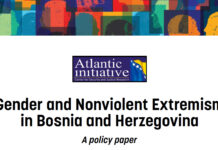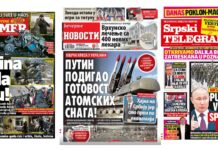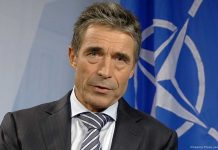A NATO-led peacekeeping force known as KFOR has remained here ever since, helping the fledgling country get on its feet. But NATO, facing demanding commitments in Afghanistan and potentially elsewhere, is itching to pull out of Kosovo. This raises the basic question of whether Kosovo can survive without KFOR, or even with a sharply reduced NATO presence, which now seems the most the alliance will provide.
KFOR troops from more than 30 different countries dot the landscape in Kosovo. Their olive-green vehicles patrol the roads; their camouflage-uniformed soldiers, with patches showing the flags of their country of origin, walk the streets and stand guard at potential flash points. Their presence acts as a deterrent to potential troublemakers and serves as a constant reminder that peace here is fragile.
NATO’s initial force in Kosovo counted 50,000 troops. Not surprisingly, that number gradually decreased as the situation stabilized. In recent days, however, NATO has announced plans for such a precipitous drawdown that some of its own high officials may have been surprised by the news.
Until recently, KFOR numbered 15,000 soldiers and had decided to drop that number by one-third. On May 19, NATO commander Adm. James Stavridis said he would likely recommend later this year that the number come down to as low as 5,000. But only two days later, the political head of the alliance, NATO Secretary-General Anders Fogh Rasmussen came to Pristina and announced that not only was the number of troops now already below 10,000, but that NATO had decided to further cut the number of KFOR troops to 5,700. Rasmussen said the number of KFOR personnel on the ground would ultimately go down to a stunningly low 2,000.
The NATO chief spoke reassuringly of the decision-making process, vowing that, “No steps will be taken until we feel confident that the security situation allows it.”
What would happen if KFOR left? Opinions vary greatly. Walking down a narrow, curving street in the old Ottoman city of Prizren in the south, a longtime Prizren resident pointed to the hills. There, like ghosts, still stand the charred husks of burned out homes where Kosovar Serbs used to live, set ablaze by ethnic Albanians in 2004 — fully five years after the end of the war. At the time, the German KFOR peacekeeping troops watched and did nothing to stop it, the man said. But calm has since returned. The German soldiers walk the streets, and KFOR chopper blades slice the air, sending the inescapable warning of a powerful military presence.
He and his friends, the man told me, have discussed what would happen without KFOR. They concluded that it would take six hours before Serbians forces would return. That’s about how long it takes to drive from Belgrade to Prizren. Whether or not their fears are founded, they reveal the deep-rooted mistrust that persists beneath the fragile calm.
Another threat comes from extremist ideological currents trying to break into secular Kosovo. Last week, 120 Kosovar police officers swept up a group described as members of a Wahabbi Islamic sect near Prizren. They confiscated automatic firearms, military uniforms, and laptop computers reportedly containing information on potential targets. Some of the men came from neighboring Bosnia, where Islamic radicalism has made inroads.
The most visible threat to Kosovo’s security, however, looms in the north, and it comes from within Kosovo’s own borders. Kosovars — both Albanians and Serbs — living in the divided city of Mitrovica remain trapped in the stagnant air of a 10-year-old status quo. Ethnic Serbs and Albanians, former neighbors and friends, don’t even gaze at each other from their respective sides of the river Ibar.
The river cuts the city like an inflamed scar. The economy is barely alive. Some 80 percent of the population has no work. The only hospital remains in the north, forcing gravely ill patients south of the river to travel by ambulance to Pristina. Nobody invests in Mitrovica because no one is fooled by the thin veneer of stability. Without KFOR there, violence would undoubtedly break out again.
In other parts of the country, NATO forces that once protected ethnic Albanians from Serbian forces now protect ethnic Serbs from the potential threat of militant Albanians. Italian KFOR troops stand guard at the Serbian Orthodox Patriarchate in Peja, and Swedish troops protect the ancient Gracanica monastery and the town that surrounds it. Similar scenes occur in just about every remaining Serbian enclave in Kosovo.
Rasmussen downplayed the depth of the conflicts that persist in this battered corner of the Balkans. “Of course, there are political complications and occasional security incidents,” he said during his visit to Pristina, “but the general trend is stable and moving in the right direction.”
Kosovo’s prime minister said he welcomed NATO’s troop-reduction plans as a sign of confidence in Kosovo’s future. But others are warning that violence could easily return. Only days before Rasmussen’s optimistic assessment of the situation, the U.N.’s special representative to Kosovo, Lamberto Zannier, told the U.N. Security Council that the risk of social unrest in Kosovo continues in the absence of progress towards reconciliation between Serbs and Albanians.
Kosovo’s ability to resolve its own conflicts more than a decade after the international community launched its massive nation-building effort remains deeply disappointing. A new analysis by the International Crisis Group concluded that “the country’s justice system is failing its citizens.” The report pointed to a growing problem with organized crime, corruption, political interference with law enforcement, and abuse of power by public officials. Against this background, the prospects for creating an environment where minorities feel safe look dim. And as long as the Serbian minority can make a credible argument that it is unfairly treated by the majority in Kosovo, the threat that Serbia will take up their case, even by force, cannot be ruled out. Without justice, peace cannot be assured.
KFOR rode in on a wave of affection and gratitude from Kosovo’s Albanians, greeted as liberators. NATO eventually earned the respect of many Serbians, too. For now, NATO can confidently count Kosovo as one of its success stories. But if it departs too soon, it may find that it has pried defeat out of the jaws of victory.
Frida Ghitis is an independent commentator on world affairs and a World Politics Review contributing editor. HeHer weekly column, World Citizen, appears every Thursday.
27.05.2010.
From Web: http://www.worldpoliticsreview.com/articles/5628/world-citizen-can-kosovo-make-it-without-nato
Photo: http://www.nato.int/cps/en/natolive/photos_63915.htm?single=photos_63883.htm







